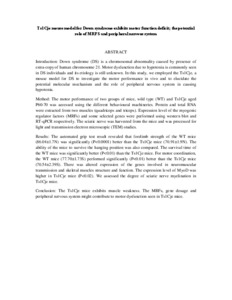Citation
Bala, Usman and Othman, Fauziah and Lai, Mei I. and Ling, King Hwa and Cheah, Pike See
(2015)
Ts1Cje mouse model for Down syndrome exhibits motor function deficit; the potential role of MRFS and peripheral nervous system.
In: 26th Annual Scientific Meeting of Malaysian Society of Neurosciences (MSN 2015), 5-7 June 2015, WEIL Hotel, Ipoh, Perak. (p. 40).
Abstract
Introduction: Down syndrome (DS) is a chromosomal abnormality caused by presence of extra-copy of human chromosome 21. Motor dysfunction due to hypotonia is commonly seen in DS individuals and its etiology is still unknown. In this study, we employed the Ts1Cje, a mouse model for DS to investigate the motor performance in vivo and to elucidate the potential molecular mechanism and the role of peripheral nervous system in causing hypotonia.
Method: The motor performance of two groups of mice, wild type (WT) and Ts1Cje aged P60-70 was accessed using the different behavioural machineries. Protein and total RNA were extracted from two muscles (quadriceps and triceps). Expression level of the myogenic regulator factors (MRFs) and some selected genes were performed using western blot and RT-qPCR respectively. The sciatic nerve was harvested from the mice and was processed for light and transmission electron microscopic (TEM) studies.
Results: The automated grip test result revealed that forelimb strength of the WT mice (86.04±1.7N) was significantly (P<0.0001) better than the Ts1Cje mice (70.91±1.9N). The ability of the mice to survive the hanging position was also compared. The survival time of the WT mice was significantly better (P<0.01) than the Ts1Cje mice. For motor coordination, the WT mice (77.70±1.73S) performed significantly (P<0.01) better than the Ts1Cje mice (70.54±2.39S). There was altered expression of the genes involved in neuromuscular transmission and skeletal muscles structure and function. The expression level of MyoD was higher in Ts1Cje mice (P<0.02). We assessed the degree of sciatic nerve myelination in Ts1Cje mice.
Conclusion: The Ts1Cje mice exhibits muscle weakness. The MRFs, gene dosage and peripheral nervous system might contribute to motor dysfunction seen in Ts1Cje mice.
Download File
![[img]](http://psasir.upm.edu.my/75605/1.hassmallThumbnailVersion/Ts1Cje%20mouse%20model%20for%20Down%20syndrome%20exhibits%20motor%20function%20deficit%3B%20the%20potential%20role%20of%20MRFS%20and%20peripheral%20nervous%20system.pdf)  Preview |
|
Text (Abstract)
Ts1Cje mouse model for Down syndrome exhibits motor function deficit; the potential role of MRFS and peripheral nervous system.pdf
Download (39kB)
| Preview
|
|
Additional Metadata
Actions (login required)
 |
View Item |

